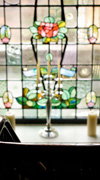Send an enquiry Tel: +44 (0)131 667 5806 Fax: +44 (0)131 667 6833 Email: info@23mayfield.co.uk
People have been living on Castlehill for the last 7000 years . The castle area has been a hillfort for over 2000 years. The name Edinburgh comes from the ancient Gaelic "Dun Eidyn" which means 'hill fort on the sloping ridge'. The Royal Mile runs down the East shoulder of this once active volcano and this is what gives the Royal mile its distinguishable geographical location. It was 325 million years ago during an ice age that the immense pressure of moving glaciers carved out its profile.
The Royal Mile is actually more than a mile by 107 yards. It starts at the Castle entrance to the gates of Holyrood Palace. From the Castle esplanade which leads into the Royal Mile as you walk down the hill travelling East there are several streets which connect to make up the Royal Mile. Castlehill, Lawnmarket, High Street, Cannongate, and Abbey Strand which leads to Holyrood Palace.
It was in 1124 when King David I saw the hill fort on the crag and the clachan or village which supplied goods to the noblemen, soldiers, and monks in the fort. David I was immediately inspired to remodel what had become by 1128 the Burgh of Eiden. He granted trading rights to the township and the Lawnmarket became an open air trading market. He then went about setting out the High Street which even then was referred to as Via Regis which means the Way of the King. It is possible that this is where the name Royal Mile originates.
Grand timber buildings were constructed and named after the landowners and this tradition can still be seen today on the present Royal Mile. The gaps between the buildings are called closes after the 'dividing enclosures'. The enclosures had large gardens which housed livestock. This medieval garden city was destroyed, its houses burned in 1544 by the English, during the period called the Rough Wooing. Henry VIII of England ordered its destruction because he was trying to force the Scots to allow his son to marry the infant Mary (Queen of Scots). By 1591 the houses were mostly made of stone but the overcrowding conditions were becoming increasingly unsanitary, although within the Cannongate the nobility were living in grand mansions with lovely gardens.
By 1645 things were far worse with as many as 70,000 people living within the Royal Mile. Some buildings were fourteen stories high and there could be three hundred people living in one block with up to ten people sharing a single room. It wasn't until the end of the 18th century that street cleaning was organised.
The publisher and Lord Provost William Chambers in 1865 began to change all this and two years later extensive modern restorations had been carried out. He built the new tenements on Blackfriars Street and St Mary's Street. The Old West Bow was demolished, and Cockburn Street cut through a maze of buildings joining it to the train station.
Further work was carried out in the 1880's by Patrick Geddes, town planner and Botanist, who remodelled the Cannongate section and the top of the Mound. He designed courtyards and gardens which were reminisant of what the Royal Mile had looked like 500 years earlier.
23 Mayfield is only one mile from the Royal Mile.

A selection of seasonal offers are available at selected times throughout the year.

Find out what's on the menu and start your day off in an award winning fashion!

Edinburgh is rightly regarded as one of the finest cities in the World. And no wonder...